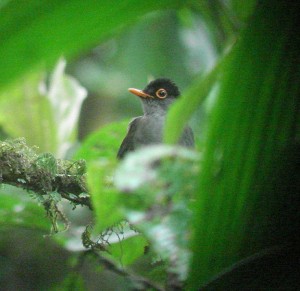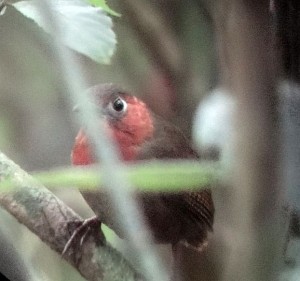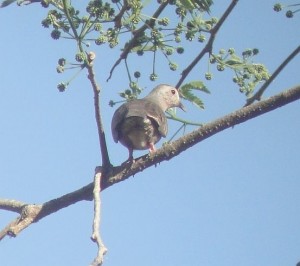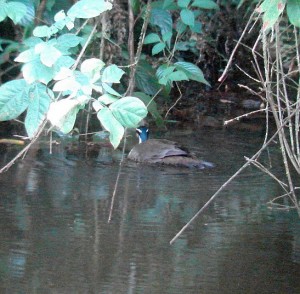The dry season on the Pacific slope is quickly coming to an end and that’s very welcome news because we could use the rain! This year’s dry season seemed to be especially bereft of agua as the sun hammered the fields into a brown landscape with relentless UV rays. Nevertheless, since the birds that live there are adapted to dealing with a pronounced dry season, I doubt they will be very much affected by it.

With the end of the dry season comes the start of the low season for tourism. Most birding tours come here between January and April because this is the ideal time to visit if you want to see more migrants and experience less rain on the Pacific slope. However, if you don’t mind missing out on bunches of Chestnut-sided Warblers and seeing Summer Tanagers, the birding still happens to be great from now until the second half of October (from then until December the rain can be a problem). The cloudy weather makes for higher levels of bird activity and cooler weather, so if you headed to Costa Rica for birding in the near future, consider yourself lucky because you could end up seeing more resident species than during the dry season.
In addition to that little tidbit, here are a few other updates and perspectives about birding in Costa Rica in 2013:
Bamboo on Poas: Last year was a bonanza for bamboo on the flanks of Poas. Trips to that area and Varablanca turned up multiple Peg-billed Finches, Barred Parakeets, and even several Slaty Finches (!). On recent trips to Poas, I noticed that the bamboo is starting to seed again (!), this time in the bamboo just above the area that had seeded last year. Since it seems that most of the forest understory from the entrance gate to the payment booths will be filled with seeding bamboo, this should be a good area to check for Maroon-chested Ground Dove (I will be watching for it!).


Head to the Nature Pavilion for bird photography: The Nature Pavilion is fast becoming a must stop for anyone interested in taking pictures of birds. Ok, so you don’t absolutely need to go there for birding but if you do, you have a much better chance of getting many pictures of tanagers, honeycreepers, toucans, and a litany of other colorful birds that come to their feeders. The owners are always working to improve the already quality experience and the deck is also good for watching canopy species (and the river a good place to check for Sunbittern and Fasciated Tiger Heron).

Don’t expect to enter Quebrada Gonzalez and pay later: Since the national park officially opens at 8, unfortunately, birders aren’t supposed to enter before then (which happens to be during ideal birding times). Friends of mine were sort of berated recently for doing this by the park guard manager. He mentioned, though, that people can enter early but need to contact him in advance. Unfortunately, there isn’t any easy way of contacting him! However, blame him less than the general bureaucracy that plagues so much of Costa Rica. One of my dreams is to convince or help the people in the Costa Rican national park system to better manage the parks for tourism. Not managed for tourists? What? Yes, that is exactly the case. A couple of parks are better managed for visitors but the majority really aren’t. Solutions could include marketing of the parks for visitors and investing in them for this purpose. For example, in Braulio Carillo, convert part of the ranger station into a souvenir shop and small cafe with proceeds going towards the budget for the station. Put in a small canopy tower somewhere in the park and charge $5 or $10 extra to use it. Make the loop trail longer. Hold scheduled night walks and other educational walks for the public. Most of all, open the park at 6 and close it at 5 instead of 8 to 4. The same goes for every other national park in the country. More money would be generated for the parks, tourists would have a more satisfying experience, and more people would visit the parks thus generating more funding, etc.
Visit El Tapir instead: Although you can’t enter Quebrada at the earliest hour, there is an easy solution to this dawn chorus dilemma. It’s called El Tapir and it’s just down the road from Quebrada. El Tapir doesn’t have a sign so watch for the first place with a couple of small buildings on the right after passing Quebrada Gonzalez and continuing on towards Guapiles and Limon (maybe 2 ks past the station). Head in through the barbed wire gate as early as you want and pay the caretaker $5 (2,500 colones) when he shows up. The forest is excellent, has many of the same species as Quebrada, and they usually maintain two trails. This site has tons of potential so be ready for anything when birding back towards the stream (think Slaty-backed Forest Falcon, Ground Cuckoo, Sharpbill, and Gray-headed Pripites as possbilities). The main downside is the high number of ticks that occur on the trails so be prepared! There isn’t any restroom either but consolation is that you have a chance at seeing any number of rare foothill forest species. Of course the flowering Porterweed is also excellent for Snowcap, Black-crested Coquette, and many other hummingbirds while hawk-eagles and other raptors can show up in the sky.

Want to support bird habitat? Don’t eat Costa Rican pineapple.: It’s as simple as that. Although some pineapple has been certified as sustainable, I really don’t see how that is possible given the high amount of pesticides that are used even on those supposedly green farms. I think the green label was earned because attempts are made to protect some forest corridors (which probably aren’t actually large enough to support species that are susceptible to edge effects). Vast monocultures of pineapple have become the number one problem for biodiversity in Costa Rica because huge areas are drained and cleared, planted with pineapple, and then drowned with chemicals. This is clearly not sustainable but it’s important for the economy in the short term so little has been done to improve the situation. On a personal note, I love pineapple and would be happy to eat it and support farms that grow it but only if it’s grown in a way that doesn’t eliminate biodiversity, pollute water, increase sedimentation of waterways, harm people with chemicals, and decrease the value of land and quality of life in a long term manner. Is that too much to ask?

Want to see more birds? Visit the most intact forests: A lot of birders visiting Costa Rica mention how they saw more in the gardens of their hotels or at the forest edge than in the rainforest itself. Veteran birders, though, make efforts to spend more time inside and near large areas of tropical forest because they know that this is the only way to see most of the uncommon and rare species in the field guide that they missed on previous trips. Those birds were probably missed by merit of their naturally rare status, and because more time was spent watching birds at the forest edge than in the shady depths of primary rainforest. The fact of the matter is that although you can see more individual birds in gardens and the edge of the forest, you will see more species if you combine that with birding inside extensive primary forest to see things like wood-quail, tinamous, antbirds, certain flycatchers and wrens, and dozens of other uncommon species. While birding in old growth forest is far from easy, it represents high quality habitat for the majority of bird species that occur in Costa Rica simply because it’s the type of habitat that they became adapted to using for the past million (or more) years.
It’s no surprise that the sites with the largest areas of high quality forest also offer your best chances at seeing uncommon species like forest raptors, cotingas, antbirds, Song Wren, leaftossers, etc. Some examples of such sites are Bosque del Rio Tigre and Luna Lodge in the Osa Peninsula, Pocosol Biological Station, Hitoy Cerere, El Copal, Rincon de la Vieja, and the Monteverde cloud forests.

Don’t expect to bird the La Selva entrance road unless you stay there or take a tour: The entrance road has definitely become off limits to anyone not staying at the station or taking a scheduled tour. It’s a shame but the station probably did it to make it more difficult for poachers and potential thieves from entering the La Selva property. Regarding staying at La Selva, pay the high price for mediochre lodging and food if you want to support research of tropical forests. If you would rather stay somewhere that is more comfortable and geared towards tourism, pick one of the many hotels in the area and visit La Selva on the early birding tour. Keep in mind that La Selva is first and foremost a biological station and ecotourism is not their highest priority. This is why you won’t be allowed to go up the canopy tower (yes, there is one or more but only for researchers), some trails may be off limits, and unless you stay there, access is only provided to people on one of their tours (which are usually interesting and educational). Also, many understory species at La Selva have become rare (probably due to overgrazing by an overabundance of Collared Peccaries) so don’t expect to see various antwrens, antbirds, White-fronted Nunbird, Carmiol’s Tanager, understory flycatchers, and many other formerly common species still on the list. Most of those can still show up and will hopefully some day recover but they are far more rare than they used to be. I don’t mention this to make La Selva look bad, and it’s still a great place for birding and bird photography, I write this so you know what to expect.

Changes at Heliconias Lodge and two other excellent, little known sites up that way: I have heard rumors that the community that owns (or owned) Heliconias Lodge has franchised it out. I haven’t been up there since then but I have been told that one of the excellent bird guides who used to work there is no longer there and there could be other changes in store. Their website is still the same though so hopefully it won’t be all that different and owls will still be staked out because this is one of the best birding sites in the country. I have also heard about two other small lodges on the Caribbean slope of the northern volcanoes. One is Cataratas Bijagua Lodge, and the other is Albergue Ecologico Las Bromelias. Cataratas Bijagua looks like a cozy, moderately-priced place that probably has some great birding right on the grounds and on the trails. Could also act as a good base for visiting other sites in the areas as well as Cano Negro. Las Bromelias is a bit harder to get to but friends who have been there tell me that it was very much worth the effort. It’s also moderately priced and is very good birding (they told tales of 17 species of hummingbirds, both Keel-billed and Tody Motmots, Bare-crowned Antbird, and an antswarm!).

Hope to see you in some Costa Rican rainforest during the low season!

















